An innovative new concept designed to relieve congestion at the gate is the product of two brothers’ very different areas of expertise. The elder of the two, Raymond King of Aviation & Airports International Corp, gives his insight into how the idea came to fruition.
This story is about two brothers, who at different times shared a common table in a three-bedroom terrace home along with four other brothers and a sister. The number two brother took his grandfather’s advice and experienced aviation, with lots of travel. The number four brother pursued a career in the rail industry, both domestically and internationally, gaining high-speed rail experience.
A victim of its own success
Why is this important? Well, an idea was born from a compulsion to do something for an industry that was straining under the pressure of growth, which was both a blessing and a challenge. A case in point relates to an Asia Pacific conference where one of the speakers, John D’ Arcy Meredith, then of the International Air Transport Association (IATA), expressed concern that current congestion in Europe was costing about $5bn (in 1992) and would climb to $10bn by 2000. The US Department of Transportation indicated costs of $40bn for congestion in the United States alone by 2007. The US Travel Association quoted a similar figure. Extrapolating the US and Europe estimates, therefore, the figure would have been about $70bn for 2013.
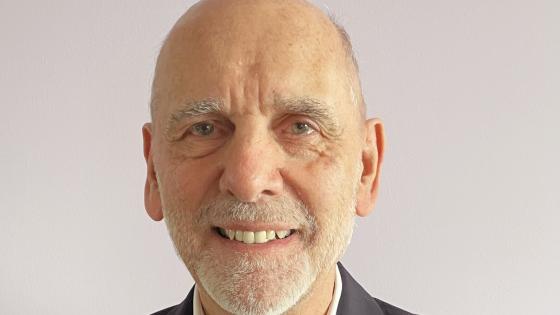
Raymond King founded Aviation & Airports International Corp (“AAIC”) in 1995
According to the Department for Transport in the UK, rail travel has doubled since rail privatisation in 1994/95, while car use has fallen by more than 10%. About 200 airports around the world have rail links, and more are planning to improve accessibility (see page 36). They do so not only with an eye on the environment, but to provide choice for passengers who wish to avoid road congestion on the way to the airport, according to Paul Le Blond, formerly of the International Air Rail Organisation. So, transport is becoming more integrated, ahead of the International Civil Aviation Organization (ICAO) and IATA’s forecast of double air passenger growth by 2037.
At the gate
But what about congestion at the gate? Late arrivals and late departures all contribute to the statistics, but the fact is that the industry can build aircraft faster than they can slots at an airport, so what can be done? Perhaps a move away from dedicated gates, or schedules spread out rather than the hot/cold/hot cycle, to avoid banks of aircraft waiting for too few gates. What if turnaround times could be reduced to generate slots throughout the day, for all types of aircraft? This topic alone is a strong business case for change.
With maintenance at the gate pre-planned to match service cell times, known repairs will be handled efficiently, thereby reducing technical delays. Non-planned repairs will receive attention at the cell, or at the ramp.
Suppose taxiing was carried out in a uni-directional manner so that aircraft approached the terminal all in the same way, and left the cell to return to service? Gate operations would be simplified. With no pushback there would be no time impact on other aircraft in the vicinity.
Recent media coverage of the industry’s challenges has become so routine we ask ourselves how the situation can be addressed. The air transportation business has done a marvellous job of getting five billion passengers a year safely from city to city, however, it must be recognised that the model of legacy terminals, if repeatedly built to match growth, only succeeds in doubling the challenges of escalating costs and space requirements, making it an unsustainable model. City regional airports, for instance, are in many cases landlocked, leaving them no room for expansion.
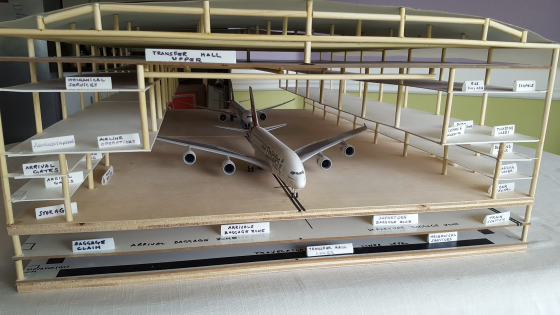
Elevated departure and arrival lounges connect passengers to multi-zonal boarding bridges
Where Symphony comes in
Back to the brothers, their respective careers and the idea that history can be repeated. We are reminded that our great grandfathers adopted the standard gauge rail system, opening up the terminals (the equivalent of legacy airports) to become stations (in line with the Symphony idea), all operating on the same size of track. The rail industry flourished globally, with passengers now able to take long journeys faster than before, seamlessly, and with less hassle.
The oldest terminal station was Crown Street, built in Liverpool in 1830. The Gauge Act of 1846 decreed that future tracks should all be narrow gauge, but permitted the broad tracks to remain. This meant it took some 16 years for the move from terminals to stations.
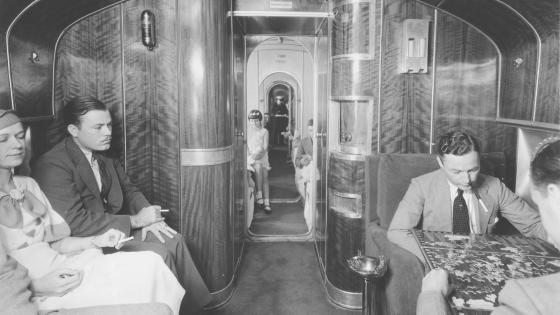
Looking down the 50ft main aisle of a Pan American Airways Flying Clipper Ship, early to mid-20th century
Fast forward to air travel which has adopted terminal design for airports over the last seven decades. The challenge has been managing the participants, all five billion of them! So, we must honour and congratulate the industry that has brought about the world’s safest transportation system, while conducting business every day of the year. The pending challenge, however, is whether the system will cope with eight billion passengers.
In terms of cost, congestion is the largest expense, some of which must be borne by ticket tax and levied against earnings, thus reducing revenue generation. Recently, congestion’s cost to industry was about equal to the combined net earnings of the airlines. Little is heard or read about how new technologies could be embraced to bring about a solution to solve congestion.
When it comes to contemplating the future of airport terminal buildings, it is not just about the building, it is about starting now to get operational methodology right. After all, anyone can build, but it takes a village to make the building function properly. Apart from congestion’s cost burden, other costs, such as footprint, distance to gates, and environment protocols, could be addressed, to ensure any changes satisfy the whole village.
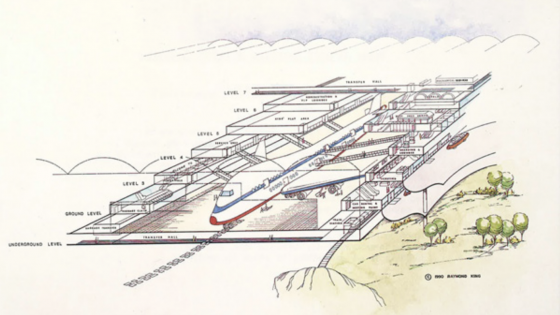
The Symphony terminal will be compact, enabling trains to stop close to aircraft, with direct vertical access from station platform to gate
With the industry’s reputation for being cautious in adopting new technology, and acquisition costs climbing, perhaps the development of airport terminals could twin the old and the new side by side, so that the new technologies can gain operational experience before scaling up for growth.
The rail industry claims 200 years of locomotive technology, according to online data and information resource Railway Technology, which highlights the changes in fuels from steam, to electrification, dieselisation, diesel/electric, liquified natural gas (LNG), to hydrail using sustainable hydrogen fuel cells instead of diesel engines, and maglev. Speeds have gone from walking speed to 574kph by France’s Train à Grande Vitesse (TGV) in 2007, to 603kph by the Japanese experimental magnetic levitation track in 2015. Emissions for main line railways are quoted by the Department for Transport as 36.6g CO2e/per passenger kilometre.
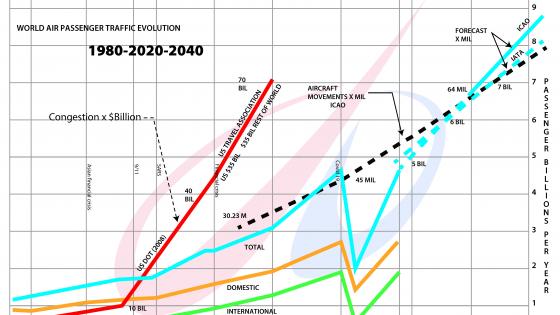
Air congestion is a growing problem
Destiny’s role
It could be said that destiny brought the two brothers together, and so one day we found ourselves walking over a footbridge on the UK’s Cranfield University campus to meet with the faculty of the Centre for Air Transport Management. Going over the bridge, we agreed our parents would be proud. At that meeting ideas on new approaches to airport terminal design/operations were discussed.
The parents had the last say, having told their children that “there is no such word as can’t in this house, so find a way”. Naturally, myself and Gordon adopted this philosophy, so now we plan to bring the Symphony idea to market – with the help of the village.
